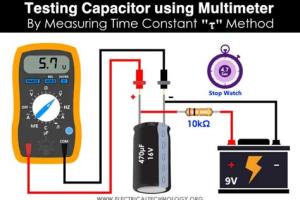Ultimate Guide on How to Measure Capacitance: Techniques and Tools Explained

-
Quick Links:
- 1. Introduction
- 2. Understanding Capacitance
- 3. Importance of Measuring Capacitance
- 4. Techniques for Measuring Capacitance
- 4.1 Using a Digital Multimeter
- 4.2 Using a Capacitance Meter
- 4.3 Using an Oscilloscope
- 4.4 Using an LCR Meter
- 5. Step-by-Step Guides
- 6. Case Studies
- 7. Common Mistakes When Measuring Capacitance
- 8. Expert Insights
- 9. Conclusion
- 10. FAQs
1. Introduction
Capacitance is a fundamental property of electrical components that plays a crucial role in electronic circuits. Understanding how to measure capacitance accurately is essential for engineers, technicians, and hobbyists alike. In this comprehensive guide, we will explore various techniques and tools available for measuring capacitance, and provide step-by-step instructions to help you master this skill.
2. Understanding Capacitance
Capacitance is defined as the ability of a system to store an electric charge. It is measured in farads (F), where one farad is the capacitance of a capacitor that stores one coulomb of charge at one volt. Capacitors are commonly used in various applications, from energy storage to filtering signals in electronic circuits.
3. Importance of Measuring Capacitance
Measuring capacitance is essential for:
- Diagnosing faulty capacitors in electronic devices.
- Ensuring that capacitors meet required specifications in circuit design.
- Maintaining the performance and longevity of electrical equipment.
4. Techniques for Measuring Capacitance
There are several techniques available for measuring capacitance, each with its own advantages and applications. Below, we will delve into the most commonly used methods.
4.1 Using a Digital Multimeter
Digital multimeters (DMMs) are versatile tools that can measure various electrical properties, including capacitance. Here’s how to use a DMM to measure capacitance:
- Turn off the power to the circuit and discharge the capacitor.
- Set the multimeter to the capacitance measurement mode (often denoted by a capacitor symbol).
- Connect the multimeter leads to the capacitor terminals.
- Read the capacitance value displayed on the multimeter.
4.2 Using a Capacitance Meter
A capacitance meter is a specialized tool designed specifically for measuring capacitance. To use a capacitance meter:
- Select the appropriate measurement range on the meter.
- Connect the capacitor to the meter’s terminals.
- Press the measurement button and wait for the reading to stabilize.
- Record the capacitance value displayed.
4.3 Using an Oscilloscope
An oscilloscope can be used to measure capacitance indirectly by analyzing the charging and discharging curves of a capacitor. This method is more complex and requires a good understanding of oscilloscopes.
4.4 Using an LCR Meter
LCR meters measure inductance (L), capacitance (C), and resistance (R). To measure capacitance with an LCR meter:
- Connect the capacitor to the LCR meter.
- Select the capacitance measurement mode.
- Press the measurement button and record the value.
5. Step-by-Step Guides
This section will provide detailed step-by-step guides for measuring capacitance using the aforementioned methods. Each guide will include tips for ensuring accurate measurements and troubleshooting common issues.
6. Case Studies
In this section, we will explore real-world case studies that highlight the importance of measuring capacitance accurately. These examples will illustrate the impact of proper capacitance measurement on various applications, including consumer electronics and industrial systems.
7. Common Mistakes When Measuring Capacitance
Here are some common pitfalls to avoid when measuring capacitance:
- Failing to discharge capacitors before measurement.
- Using the wrong measurement setting on the multimeter.
- Neglecting to account for parallel capacitors in a circuit.
8. Expert Insights
Industry experts share their insights on the best practices for measuring capacitance, including tips for accuracy and reliability in measurements.
9. Conclusion
Measuring capacitance is a vital skill for anyone working with electronic components. By understanding different measurement techniques and following the guidelines provided in this article, you can ensure accurate and reliable capacitance measurements.
10. FAQs
1. What is capacitance?
Capacitance is the ability of a component to store an electric charge, measured in farads (F).
2. How do I know if a capacitor is bad?
Symptoms include physical damage, leakage, and incorrect capacitance readings upon measurement.
3. Can I measure capacitance while the circuit is powered?
No, always ensure the circuit is powered off and capacitors are discharged before measuring.
4. What is the difference between ESR and capacitance?
Equivalent Series Resistance (ESR) affects performance, while capacitance is the charge storage capability.
5. How does temperature affect capacitance measurements?
Temperature changes can affect dielectric properties and, consequently, capacitance readings.
6. Can I measure capacitance with a smartphone?
Some apps can measure capacitance using phone sensors, but accuracy may vary.
7. What tools are best for measuring large capacitors?
Capacitance meters and LCR meters are ideal for measuring large capacitors accurately.
8. Why are my capacitance measurements inconsistent?
Inconsistencies can be due to poor connections, incorrect settings, or faulty capacitors.
9. What is the significance of capacitance in circuits?
Capacitance plays a critical role in filtering, timing, and energy storage in circuits.
10. How can I improve measurement accuracy?
Ensure proper connections, calibrate your meter, and take multiple readings for better accuracy.
Random Reads
- How to keep a room cool
- How to join zoom meeting pc mac
- How to use a computer
- How to use a computer keyboard
- How to use a cell phone
- How to return a steam game
- How to return an item to amazon
- How to open and edit pdf in microsoft word
- How to open advanced settings in youtube
- How to post images in discord chat